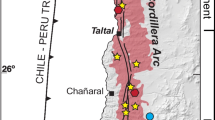Abstract.
The Northern Marginal Zone of the Rum Central Igneous Complex in NW Scotland represents part of the early, felsic phase of the volcano. The marginal zone is a relic of the early caldera floor and the infilling of sedimentary and igneous rocks. Its formation has been explored through field examination of the ring fracture system of the Complex and its pyroclastic and epiclastic intracaldera facies. A sequence of magmatic tumescence and chamber growth caused initial doming, followed by the formation of a collapse structure without accompanying volcanism. This collapse structure, circular in plan, is akin in origin to a salt basin formed by crustal stretching above a rising diapir. We call this the proto-caldera. Collapse breccias, which represent the slumping and sliding of megablocks, blocks and boulders of the Torridonian sandstones which form the walls of the basin, were the original infilling. Logs of these deposits reveal considerable variation in thickness of the breccias (from 80–170 m) in the Complex, indicating an uneven floor to the proto-caldera, consistent with piecemeal collapse. Following accumulation of up to >70 m thickness of breccia, thin interbedded rhyodacitic crystal tuffs (10–30 cm) record the earliest eruptions of felsic magma in the caldera. Caldera formation was then interrupted by a period of quiescence, recorded by the presence of an epiclastic sandstone of locally several metres thickness, formed by washout of fines from the breccias. Subsequent resurgence created a fracture pattern characteristic of doming, along which rhyodacite magma rose in dykes and erupted up to perhaps 10 km3 of rhyodacitic intracaldera ignimbrites. This major eruption caused further incremental subsidence of the caldera floor into a now partly emptied magma chamber. Mafic inclusions in the ignimbrites point to the eruption being triggered by multiple injections of basic magma into a chamber occupied by felsic magma.
Similar content being viewed by others
Author information
Authors and Affiliations
Additional information
Electronic Publication
Rights and permissions
About this article
Cite this article
Troll, V., Emeleus, C. & Donaldson, C. Caldera formation in the Rum Central Igneous Complex, Scotland. Bull Volcanol 62, 301–317 (2000). https://doi.org/10.1007/s004450000099
Received:
Accepted:
Issue Date:
DOI: https://doi.org/10.1007/s004450000099




